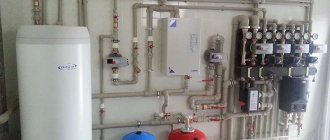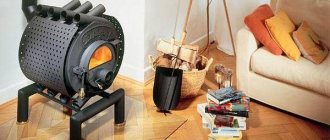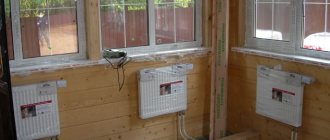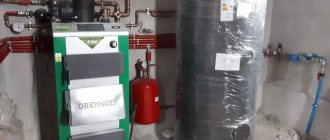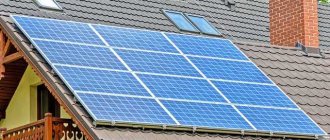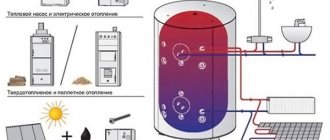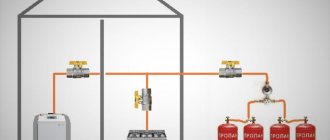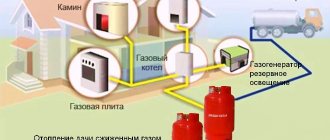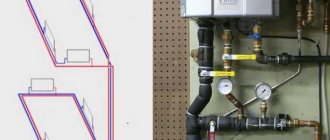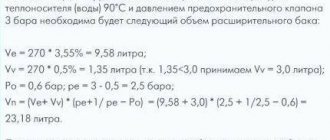The reasons for the popularity of alternative energy sources are quite understandable: there is an opportunity to save on fuel and make dreams of environmentally friendly life support systems come true. By skillfully using the energy of the sun, wind and water, you can turn an ordinary country house into a modern eco-house.
We will tell you how to install solar heating in a private home, and we will analyze with you how profitable it is. In order to thoroughly cover the issues of using daylight energy, we have described in detail all the popular options that have received practical application and positive user reviews.
Taking into account our recommendations, you can build an effective solar system for a summer house or country house. To make the difficult material easier to understand, we have supplemented the information with visual diagrams, illustrations and video tutorials.
Solar heating
The essence of the process comes down to absorbing the thermal energy of the sun and transferring it to the coolant, which, in turn, must be transferred to the heating system of the house and transfer the heat to the air in the rooms. Considering how hot water left in an open container at midday heats up, the process does not represent anything supernatural.
Unfortunately, such a system will be most effective during the period of maximum activity of the star, that is, during the period from May to August, when the sunny day has the longest duration and the least amount of precipitation falls. In the winter-autumn period, when the need for heating arises, the picture looks different.
A short sunny day already limits the life of a solar device. On cloudy days, it will not be possible to use either the collector or the battery. Therefore, it is not possible to use solar heating as the main one. However, as an alternative source of heat in winter and hot water in summer, the system is quite effective.
Tips for use
- The operation of a solar heating system is carried out in accordance with the design of the collectors, their number and other features.
- The main task for the owner is to maintain cleanliness and timely removal of dust and other contaminants . This allows for maximum thermal energy intake and increases the efficiency of the entire system as a whole.
- It is necessary to properly insulate all connecting pipelines and storage tanks , excluding heat loss.
- It is recommended to always keep one or two panels in reserve so that in case of mechanical damage you can quickly replace them. Following these simple recommendations will increase the efficiency of the system and ensure comfort and coziness in the home.
Advantages and disadvantages of solar heating
Solar heaters for any type of home have the following advantages:
- system autonomy - you will no longer depend on utility services and their prices;
- despite the high price of the equipment, the total operating cost will decrease every year;
- noiselessness;
- long service life;
- environmental safety of the generated energy;
- operation in various climatic conditions: wind, rain, snow;
- the ability to accumulate received energy.
Flaws:
- The efficiency of use decreases sharply when the photocells become very hot, so it is advisable to install additional cooling systems.
- The outer surface of the panels must be regularly cleaned of dirt and dust.
- Presence of toxic substances in photocells. During operation, they do not in any way affect the purity of the energy released, but require safe disposal.
- After 25–30 years of active use, the performance of panels drops by at least 10%.
- The efficiency of batteries directly depends on weather conditions, so they need to be equipped with additional energy storage systems.
Principle of operation
The operating principle of solar panels is to generate electrical energy; they do not accumulate or generate it in any way. When the sun's rays directly hit their surface, they are immediately converted into current and removed from the panel.
Each plate can produce 250 W, so to improve the principle of operation they try to install them closer to each other. The current obtained as a result of photosynthesis flows through the distributor into the batteries, and then into the inverter of the power grid at home.
It should be noted that the volume of solar batteries affects the duration of daily operation of the batteries. The batteries are recharged throughout the day while the energy generated the previous day is used.
The operating principle is simple and at the same time effective thanks to the “semiconductor”. A semiconductor contains atoms that, thanks to an external electron, can capture or reflect other electrons. As a result, the surface of the solar cells is covered with this material. This “semiconductor” is Selenium and Silicon.
Why are there no solar power plants on the roofs of our houses?
The Internet is replete with advertising materials with beautiful pictures telling about the extraordinary benefits of solar systems. Craftsmen post videos on YouTube on the topic “do-it-yourself solar heating” about their own know-how, assembled on their knees from scrap materials. The Internet is buzzing with reposts of enthusiastic articles about the wonderful benefits of solar heating. However, how many houses with solar collectors on the roof have appeared in recent years near your home? No one? What are the reasons that solar heating is not recognized in our area?
Unfortunately, solar energy for heating a home does not arrive when or where it is needed. It gets cold closer to the poles, in winter and at night. And the maximum solar radiation occurs in the equatorial regions, during the summer and during the day. At the very least, heat accumulators help smooth out daily, but not seasonal, differences.
Map of the intensity of distribution of sunlight across the territory of Russia. In the Western part of the country, where the lion's share of the population lives, there is little sun. And in eastern Siberia, where the share of radiation is noticeably higher, it is cold, which makes it difficult to use active systems. By the way, solar panels that generate electricity are not so sensitive to severe frosts. Quite powerful solar power plants have already been built and are successfully operating in cold but sunny Yakutia.
Passive heating with solar energy is ineffective and cannot significantly warm a house in Russian winter conditions. “Windows facing south” is a really useful design method that costs nothing, but helps optimize heating costs. But solar greenhouses, Trombe walls and their derivatives, once relatively popular in the United States, gradually faded away even in their homeland.
Active solar heating systems for a private home are very expensive; you will have to pay a lot of money for the equipment. Operation, contrary to some claims, is by no means free: electricity is consumed and equipment maintenance is required. At current prices, compared not only with cheap natural gas, but even with rather expensive pellets and diesel fuel, installing a vacuum solar collector in the vast majority of the territory of the Russian Federation will never pay off at all; the payback period exceeds the service life of the equipment. Only in some southern regions of the country can solar heating systems for a private home not be unprofitable under certain conditions.
Scientific station on Olkhon Island (Russia). The use of vacuum collectors (on the right on the roof) for preparing hot water and solar panels (on the left) for generating electricity makes sense, because there are no central communications on this rocky Baikal island. However, for proper heating in the climate of Buryatia, solar systems are not enough; the house is heated by “normal” stoves, the fuel for which is imported from the “mainland”, because it is impossible to destroy the local forest for firewood
System selection and installation
The first thing that is required when choosing a particular system is to carefully study its capabilities. It is imperative to calculate the area of the home, as well as the amount of heat required to heat it. The installation location is another significant point. Reviews suggest that it would be best to use the help of qualified specialists in this field. This is due to the fact that even with a slight miscalculation, the effectiveness of the finished solution during operation can be greatly reduced. If a solar battery for heating a house is installed correctly, it will last at least 25 years. Only 3 years are needed for its full payback. Many people do not consider this period too long, judging by the same user reviews
This allows you to become completely independent from utilities, and this is very important
The solar panel for heating the house should be installed so that the solar illumination in this place is maximum. If the selected building is not suitable for installing such a system, then you can use a neighboring building. The drive can easily be placed in the basement. There are also systems where several drives are used. In this case, their sizes will be a little more modest. Those who have decided to choose heating a private home with solar panels can confidently say that their decision was correct. Solar energy is an inexhaustible source of heat, and it is absolutely free. To do this, you only need to invest a certain amount in equipment and installation of the system, and then it will not only fully pay for itself, but will also eliminate the need to pay money to utility services.
15 Cancer Symptoms Women Most Often Ignore Many signs of cancer are similar to symptoms of other diseases or conditions, which is why they are often ignored.
Pay attention to your body. If you notice
Our ancestors slept differently than we do. What are we doing wrong? It’s hard to believe, but scientists and many historians are inclined to believe that modern man sleeps completely differently than his ancient ancestors. Initially.
How to look younger: the best haircuts for those over 30, 40, 50, 60 Girls in their 20s don’t worry about the shape and length of their hair. It seems that youth is created for experiments with appearance and daring curls. However, already last.
10 mysterious photographs that will shock Long before the advent of the Internet and the masters of Photoshop, the vast majority of photos taken were genuine. Sometimes the pictures captured were truly incredible.
What is it like to be a virgin at 30? I wonder what it’s like for women who didn’t have sex until almost middle age.
These 10 little things a man always notices in a woman Do you think your man doesn’t understand anything about female psychology? This is wrong. Not a single little thing can be hidden from the gaze of a partner who loves you. And here are 10 things.
Are solar panels beneficial for a private home?
In Western countries, the fashion for solar energy is dictated more by concern for the environment than by the search for economic benefits. Our realities are somewhat different.
At current prices for supplied electricity, a solar panel system assembled with your own hands for one private home and a family of 4 people will fully pay for itself in 4-5 years. At the same time, the service life of photocells is 20-25 years, but the batteries will have to be changed after 5-7 years, depending on the quality of the batteries.
So far, nowhere in the world (and Russia is no exception) there has been a reduction in prices for supplied electricity, so over the life of the photocells in the solar panel, the system will have time to pay for itself at least 4-5 times.
Design of a heating system using collectors
First of all, we will take a closer look at the differences in the structure and functioning of batteries and collectors.
The panel consists of several photocells interconnected on a frame made of non-energy-conducting materials.
Photoelectric converters are quite complex structures, representing a kind of sandwich of plates with different characteristics and purposes.
In addition to solar modules and special fasteners, the system consists of the following elements:
- batteries for energy storage;
- a controller that will monitor the level of charge in the battery;
- inverter - to convert direct current into alternating current.
There are two types of collectors: vacuum and flat.
Vacuum collectors consist of hollow glass tubes containing smaller diameter tubes containing an energy absorber. Smaller tubes are connected to the coolant. In the free space between them there is a vacuum that retains heat.
The principle of operation of the solar collector
Flat-plate collectors consist of a frame and reinforced glass with a photoabsorbing layer. The absorber layer is connected to the coolant tubes.
Both of these systems consist of a heat exchange circuit and a heat accumulator (liquid tank).
From the tank, water enters the heating system using a pump. To avoid heat loss, the tank must be well insulated.
Such installations should be located on the southern slope of the roof. The tilt angle should be 30–45 degrees. If the location of the house or the roof structure does not allow installing solar system panels on the roof, then you can install them on special reinforced frames or on racks fixed to the wall.
The amount of solar energy released at different times of the year varies greatly. The insolation coefficient for your place of residence can be found on the solar activity map. Knowing the insolation coefficient, you can calculate the number of modules you need.
For example, you consume energy 8 kW/h, insolation is on average 2 kW/h. Solar panel power – 250 W (0.25 kW). Let's do the calculations: 8 / 2 / 0.25 = 16 pieces - this is exactly the number of panels you will need.
Varieties
Solar energy used for heating can be converted by two types of equipment:
- batteries – produce electric current, which is then supplied to electrical equipment;
- collectors - the coolant (liquid) is heated in them, which gives off its heat.
The solar collector for heating can be connected to an existing heat supply system. You can also use this device to heat water.
Active heating sunlight collected by vacuum collectors
Airborne solar collector
An airborne solar collector, equipped with a system of forced transmission and distribution of energy, is capable of producing much more heat compared to the passive option. The air circulation speed is automatically adjusted depending on the temperature in the house and the degree of heating of the collector. The air heated in the collectors can enter the ventilation system or room directly. If its temperature is high enough, it can also be used to heat the coolant liquid. Excess energy from the day is stored overnight in heat accumulators.
Solar air heating based on a solar collector. From the hollow panel (1) through the air channels (6), the fan drives air into the technical room, where automation, depending on the situation, distributes it to the air treatment unit (3) or a massive heat accumulator (2). At the same time, the hot water supply coil (5) can also heat up. During the day, when the rooms need heating, the system operates in mode B, warm air from the collector is directed to the rooms. When the required temperature in the house is reached, the air flow is redirected to the heat accumulator, mode A. At night, when the collector does not provide heat, the damper closes the channel leading to it, circulation is carried out between the heat accumulator and the rooms.
Vacuum solar collector
The most advanced solar heating device to date.
Schematic diagram of a vacuum solar collector. The liquid absorber circulating through the U-shaped tubes evaporates when heated and rises upward into the collector. The latter is connected to the circuit of the heating system and, in turn, coolant fluid circulates through it. The absorber releases energy to the coolant, cools, condenses, and falls down. The cycle repeats
Solar heating of a country house based on vacuum collectors is much more effective than other solar systems, however, in addition to the traditional uneven heat generation for solar systems, it has three more significant drawbacks: in severe frost, heat transfer drops sharply, the installations are fragile and expensive.
Vacuum solar collectors should be installed in such a way that they are protected from vandals. This is especially true for our country; getting a pebble into a glass tube is a nice thing
Vacuum panels are not connected directly to the heating system. At a minimum, buffer tanks are needed that will smooth out uneven heat generation.
The “correct” diagram for connecting a vacuum solar collector to a heating system. Heat is not transferred directly, but through a heat exchanger; excess heat during the day is stored at night in a heat accumulator (buffer tank)
Please note that the diagram shows a “normal” heating boiler; the solar system only complements it
Electric solar panels can only be used indirectly for heating. It is unwise to spend electricity directly on heating rooms; it can be used more rationally. For example, direct the operation of fans and automation of active solar systems.
Features of solar heating installation
Solar heating is most effective in areas characterized by a large number of sunny days (especially during the winter).
Do-it-yourself solar (solar heating) home heating should be done taking into account the specific features of the installation:
Scheme of solar panels operation. Click to enlarge.
One of the most optimal options is combined heating of the house with gas (or electric) and solar energy.
This option, characterized by the integration of solar system elements into the existing heat supply scheme, can significantly increase heating efficiency and increase economic indicators.
When carrying out work in areas characterized by low levels of insolation (the flow of direct sunlight onto a horizontal surface), special attention must be paid to the optimal choice of collector area and the correct installation. When determining the level of insolation, it should be remembered that its intensity is higher in the middle of the day
In this regard, the collector planes should be oriented in a southerly direction. There may be some deviations in the southwest or southeast directions
When determining the level of insolation, it should be remembered that its intensity is higher in the middle of the day. In this regard, the collector planes should be oriented in a southerly direction. Some deviations in the southwest or southeast directions are possible.
When installing collectors, it is necessary to ensure that shadows from neighboring buildings or trees do not fall on them. Installing collectors at an angle equal to the geographic latitude of a given area can significantly increase their efficiency.
This is due to the fact that the maximum level of solar energy absorption occurs on collector surfaces located at right angles to the direction of insolation.
That is why it is necessary to increase the angle of inclination, which will increase the efficiency of the collector in winter, slightly increasing heat loss in summer. However, in summer, an increase in heat losses is quite acceptable due to an excess of thermal energy.
Method for increasing productivity
Usually, after experimenting with a small number of solar modules, private home owners go further and improve the system in various ways.
The easiest way is to increase the number of modules involved, accordingly, attract additional space to accommodate them and purchase more powerful related equipment
What to do if there is a shortage of free space? Here are some recommendations for increasing the efficiency of a solar station (with photocells or collectors):
- Changing the orientation of modules. Moving elements relative to the position of the sun. Simply put, installing the bulk of the panels on the south side. During long daylight hours, it is also optimal to use surfaces facing east and west.
- Tilt angle adjustment. The manufacturer usually indicates which angle is most preferable (for example, 45º), but sometimes during installation it is necessary to make adjustments taking into account geographic latitude.
- Correct choice of installation location. The roof is suitable because it is most often the highest plane and is not obscured by other objects (for example, garden trees). But there are even more suitable areas - rotating sun tracking devices.
When the elements are positioned perpendicular to the rays of the sun, the system works more efficiently, but on a stable surface (for example, a roof) this is only possible for a short period of time. To increase this, practical tracking devices have been invented.
Tracking mechanisms are dynamic platforms that rotate with their planes following the sun. Thanks to them, generator productivity increases by about 35-40% in summer, and by 10-12% in winter.
The big disadvantage of tracking devices is their high cost. In some cases, it does not pay off, so there is no point in investing in useless mechanisms.
It is estimated that 8 panels is the minimum number at which the costs will be justified over time. You can use 3-4 modules, but under one condition: if they are directly connected to the water pump, bypassing the batteries.
Just the other day, Tesla Motors announced the creation of a new type of roof - with integrated solar panels. Elon Musk said that the modified roof will be cheaper than a conventional roof with collectors or modules installed on it.
Heating a house with collector-type solar panels
At their core, collectors are really similar to solar panels, since they capture direct sunlight. An exception for the latter are thin-film plates that produce current from scattered light. As for collectors, flat models need hot solar radiation to heat water. The only option that actively supplies hot water to the pipes of the heating system all winter, even in dense clouds, is vacuum collectors
. It is the vacuum that saves precious heat.
If you decide to take the vacuum option, in this case you also have a choice - a direct or indirect water heating model. The former are considered seasonal, since the storage tank is located directly in the collector body, and tubes with a double shell, inside of which there is a vacuum environment, are directly connected to the tank. In winter, such models cannot be used, the water in them freezes.
Another thing is heating a house with solar panels of an all-season collector type. They will work even at -50 degrees and cloudy cover, since the storage tank is installed in the house. This system operates thanks to a coolant fluid moving through pipes between the spirals located inside the tank and the collector. The same liquid is poured into the cores of the vacuum tubes. The water is only in the storage tank; from it it flows through pipes into the batteries.
Where can I buy
A solar collector is a product that can only be purchased from specialized organizations and companies that either produce similar devices or are focused specifically on selling equipment that runs on alternative energy sources.
The most correct way to purchase is to find a dealer of the manufacturer of a specific device model, and then conclude an appropriate purchase and sale agreement with him. If there are no dealers of companies producing solar collectors in the region where the potential buyer lives, then you can find an organization that specializes in this group of products. These two purchase options are the most optimal, because... specialists from such companies can provide assistance in choosing a model and suggest how to perform installation.
If the above listed acquisition methods cannot be carried out, then you can turn to the Internet, where a fairly large number of companies operating specifically in this area of energy are represented. The advantage of this purchasing method will be the lower cost of the products, but the negative point is that there will be no advice or tips on choosing a model and its installation; you will have to decide everything yourself.
Solar Heating Efficiency
Solar panels are most often used as a source of renewable and free energy. Therefore, for home heating purposes, they will be effective for electric heating systems, as well as for heating water. The solar panel kit includes:
- ordinary converter;
- AC/DC converter;
- battery level sensor;
- power take-off system;
- panels and battery.
Heating for the home can be done using electric heaters. In this case, you can choose beautiful wall-mounted radiators with sensors and temperature control. to achieve the greatest savings. It is also convenient to use a system such as underfloor heating. In this case, the heating will be uniform and distributed in the room by the movement of air flows. The system will not be inferior in efficiency to a radiator or convector. And when using batteries with high power (the power can be increased by adding panels), you can use the energy to heat water. A set of solar panels for a summer house or country house in this case will not only be economical, but also useful, especially in areas where there are interruptions in the water supply or it is turned off for the summer.
In order to heat water and supply electricity to the house with maximum benefit, a solar battery is installed on the roof of the house. In this case, heating the panels will be as efficient as possible. Two batteries lead from the plates; one at a time, cold water flows to the battery, heats up and enters the external heat exchanger. Next to the boiler and distributed to the shower or sink. If the solar battery is quite large, you can try connecting radiators with coolant in the form of water. This will require a large boiler or tank, an electric pump and a heating element.
If the source of hot water will also be powered by solar energy, then it is necessary to calculate the power for it as well. On average 1 square meter of panel area per person. Approximately the same formula is used to calculate the cost of a heated floor, one square meter of panel per 10 square meters of floor.
If there are not many sunny days in the year, cloudy days and long winters prevail, it is better to use solar energy as an additional source of electricity. Also, for effective work, you should remove possible obstacles (shadow from trees) or exclude the proximity of high-rise buildings. To install the equipment and mount the panels, you can use the video instructions.
How to choose the best
In order to make the right choice and not make a mistake with the choice of the type of solar collector and its brand, you need to follow the selection criteria, which for such devices are:
- Possibility of using a solar system in the region where the equipment is to be installed;
- The power and performance of the device must correspond to the required values and usage indicators;
- The amount of heat loss - determines the efficiency of a particular model and the required number of collectors capable of providing the heated object with thermal energy;
- Possibility of installation in one or another location of the intended installation (geometric dimensions and weight);
- Quality of workmanship and reliability of assembly (manufacturer's brand);
- Service life and warranty period;
- Device cost.
By following the above criteria and studying reviews on a specific model and company that produces similar products, you can choose the best option from those offered on the relevant market.
Advantages of a solar heating system
There are several advantages of solar panels for home heating:
- All year round your home is provided with the necessary heat. You can also adjust the temperature in the house at your discretion.
- Total independence from housing and communal services. Now you don't have to pay huge heating bills.
- Solar energy is a reserve that can be used for various household needs.
- These batteries have a very good service life. They rarely fail, so you won't have to worry about having to repair or replace some components.
There are some nuances that you should pay attention to before choosing this system. After all, such a system may not be suitable for everyone.
In many ways, the quality of such a heating system depends on the geography of residence. If you live in a region where the sun does not shine every day, then such systems will be ineffective. Another disadvantage of this system is that solar panels are expensive. However, we should not forget that such a system will completely pay for itself over time.
Duration of sunshine in Russia
In order to supply the house with the necessary amount of heat, you will need from 15 to 20 square meters. meters of solar panel area. One square meter produces an average of up to 120W.
In order to receive about 500 kW of heat per month, it is necessary that there are about 20 sunny days per month.
A prerequisite is to install solar panels on the south side of the roof, since it receives the most heat. In order for solar heating to be as efficient as possible, the roof angle should be about 45 degrees. It is advisable that there are no tall trees near the house or other objects that can create shadows. The rafter system of the house must have the necessary strength and reliability. Since solar panels are not entirely lightweight, care must be taken to ensure that they do not damage the building or provoke destructive processes. The likelihood of collapse increases in winter, since at this time snow will accumulate on the roof, in addition to heavy batteries.
Solar panels are usually placed on the roof of a house
Despite the fact that solar panels are quite expensive, they are increasingly gaining popularity. They are used even where the climate is not too hot. This system can also be used as additional heating at home. Such systems are most effective in the summer months, when the sun shines almost every day. However, do not forget that the house must be heated mainly in the winter months.
Example of calculating the required power
When calculating the required power of a solar collector, calculations are often mistakenly made based on the incoming solar energy in the coldest months of the year.
The fact is that in the remaining months of the year the entire system will constantly overheat. In summer, the temperature of the coolant at the outlet of the solar collector can reach 200°C when heating steam or gas, 120°C for antifreeze, 150°C for water. If the coolant boils, it will partially evaporate. As a result, it will have to be replaced.
Manufacturers recommend proceeding from the following figures:
- provision of hot water supply no more than 70%;
- provision of the heating system no more than 30%.
The rest of the required heat must be generated by standard heating equipment. Nevertheless, with such indicators, an average of about 40% is saved per year on heating and hot water supply.
The power generated by one tube of a vacuum system depends on the geographic location. The rate of solar energy falling per 1 m2 of land per year is called insolation.
Knowing the length and diameter of the tube, you can calculate the aperture - the effective absorption area. It remains to apply the absorption and emission coefficients to calculate the power of one tube per year.
Calculation example:
The standard tube length is 1800 mm, the effective length is 1600 mm. Diameter 58 mm. Aperture is the shaded area created by the tube. Thus, the area of the shadow rectangle will be:
S = 1.6 * 0.058 = 0.0928m2
The efficiency of the middle tube is 80%, solar insolation for Moscow is about 1170 kWh/m2 per year. Thus, one tube will produce per year:
W = 0.0928 * 1170 * 0.8 = 86.86 kWh
It should be noted that this is a very rough estimate. The amount of energy generated depends on the orientation of the installation, angle, average annual temperature, etc.
You can familiarize yourself with all types of alternative energy sources and methods of their use in the presented article.
